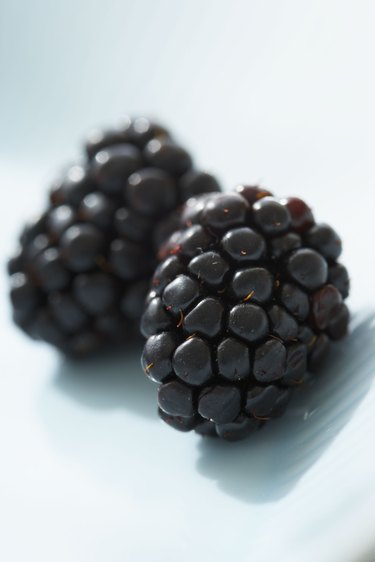
Blackberry bushes come in one of two varieties: where the plant branches remain erect or trail on the ground. While caring for the hardy perennial is relatively easy -- a wild bush grows easily in many parts of the country -- a few conditions can cause the plant's leaves to begin dying.
Overwatering
Video of the Day
Blackberry bushes need 1 to 2 inches of water a week during the growing season -- May to October -- to meet their moisture needs, and slightly more when fruit is developing. If mulch is placed around the base, it is especially important to not overwater because this can cause root rot. Leaves will begin to yellow as the plant dies.
Video of the Day
Spider Mites
These are a small pest that feed on the leaves. Leaves develop a stippled pattern, then turn yellow before turning brown and dying completely. Deter spider mites by keeping the blackberry bushes well watered and spraying an insecticidal soap on all leaves regularly -- to be reapplied after heavy rains.
Soil pH
Have the soil tested. Blackberries prefer a soil pH between 5.5 and 6.5 for optimal health. If the soil sample shows the pH is too high, lower it by adding aluminum sulfur or sulfate, sphagnum peat, iron sulfate, elemental sulfur or an acidifying nitrogen. Organic mulches placed around the plants, such as compost, can also lower the pH.
Overfertilizing
Adding too many nutrients to blackberry bushes can burn the plant, causing yellowed leaves. After planting new bushes, they can be fertilized within four to six weeks. A time-released fertilizer is usually best for young plants. Beginning with the second year, fertilize the bushes in the early spring and again in midsummer. A 10-10-10 fertilizer, which contains 10 percent nitrogen, 10 percent phosphate and 10 percent potash, is recommended. You can also add compost, or composted manure, each spring to improve the soil.
- Grow Organic: Cane Berries
- University of Maine Cooperative Extension; Growing Raspberries and Blackberries; David T. Handley; 2006
- White Flower Farm: Blackberries and Raspberries
- University of CA-Davis; Growing Blackberries in CA; Paul Vossen
- LSU Ag Center; Growing Blackberries for Pleasure & Profit; John Pyzner, et al.
- IA State Univ Cooperative Extension; How to Change Your Soil's pH; Eldon Everhart; April 1994
- Ison's Nursery & Vineyards: Blackberry, Raspberry, Dewberry and Boysenberry Cultivation
- NC Agronomic Division: A Homeowner's Guide to Fertilizer